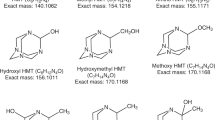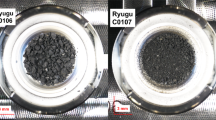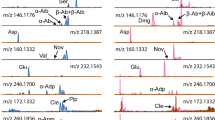Abstract
ANALYSES of the organic compounds found in the Murchison meteorite, a C2 chondrite that fell in Australia in 1969, have provided much new information about extraterrestrial organic chemical evolution. The soluble fraction of this meteorite has been shown to contain aromatic and aliphatic hydrocarbons1–4, mono-5 and dicarboxylic acids6 and various nitrogen-containing organic compounds. The latter include both amino acids2,3,7–9 and nitrogen-heterocyclic compounds10–11. The presence of amines, ureas and amides has been suggested11, although no individual compounds from these classes have been identified. Here we report the determination of aliphatic amines in water extracts of the Murchison meteorite.
This is a preview of subscription content, access via your institution
Access options
Subscribe to this journal
Receive 51 print issues and online access
$199.00 per year
only $3.90 per issue
Buy this article
- Purchase on Springer Link
- Instant access to full article PDF
Prices may be subject to local taxes which are calculated during checkout
Similar content being viewed by others
References
Pering, K. L., and Ponnamperuma, C., Science, 173, 237–239 (1971).
Kvenvolden, K., et al., Nature, 228, 923–926 (1970).
Oro', J., Gibert, J., Lichtenstein, H., Wikstrom, S., and Flory, D. A., Nature 230, 105–106 (1971).
Studier, M. H., Hayatsu, R., and Anders, E., Geochim. cosmochim. Acta, 36, 189–215 (1972).
Yuen, G. U., and Kvenvolden, K. A., Nature, 246, 301–303 (1973).
Lawless, J. G., Zeitman, B., Pereira, W. E., Summons, R. E., and Duffield, A. M., Nature, 251, 40–42 (1974).
Cronin, J. R., and Moore, C. B., Science, 172, 1327–1329 (1971).
Lawless, J. G., Geochim. cosmochim. Acta, 37, 2207–2212 (1973).
Kvenvolden, K., Lawless, J., and Ponnamperuma, C., Proc. natn. Acad. Sci. U.S.A., 68, 486–490 (1971).
Folsome, C. E., Lawless, J. G., Romiez, M., and Ponnamperuma, C., Geochim. cosmochim. Acta, 37, 455–465 (1973).
Hayatsu, R., Studier, M. H., Moore, L. P., and Anders, E., Geochim. cosmochim. Acta, 39, 471–488 (1975).
Umbreit, G. R., Nygren, R. E., and Testa, A. J., J. Chromatogr., 43, 25–32 (1969).
Smith, A. D., and Jepson, J. B., Analyt. Biochem., 18, 36–45 (1967).
Ishitoya, Y., Baba, S., and Hashimoto, I., Clin. chim. Acta, 46, 55–61 (1973).
Benson, J. R., and Hare, P. E., Proc. natn. Acad. Sci. U.S.A., 72, 619–622 (1975).
Author information
Authors and Affiliations
Rights and permissions
About this article
Cite this article
JUNGCLAUS, G., CRONIN, J., MOORE, C. et al. Aliphatic amines in the Murchison meteorite. Nature 261, 126–128 (1976). https://doi.org/10.1038/261126a0
Received:
Accepted:
Issue Date:
DOI: https://doi.org/10.1038/261126a0
This article is cited by
-
Geoelectrochemistry-driven alteration of amino acids to derivative organics in carbonaceous chondrite parent bodies
Nature Communications (2022)
-
Hayabusa2 Sample Catcher and Container: Metal-Seal System for Vacuum Encapsulation of Returned Samples with Volatiles and Organic Compounds Recovered from C-Type Asteroid Ryugu
Space Science Reviews (2017)
-
Astrobiology and the Possibility of Life on Earth and Elsewhere…
Space Science Reviews (2017)
-
Extraterrestrial Organic Matter and the Detection of Life
Space Science Reviews (2008)
-
The prebiotic synthesis of N6-methyladenine, 1-methyladenine and 1-methylhypoxanthine
Origins of life and evolution of the biosphere (1996)
Comments
By submitting a comment you agree to abide by our Terms and Community Guidelines. If you find something abusive or that does not comply with our terms or guidelines please flag it as inappropriate.



